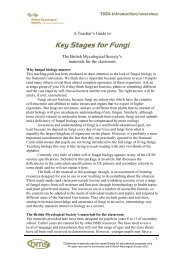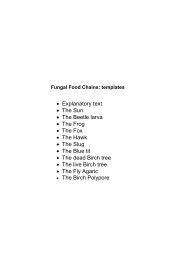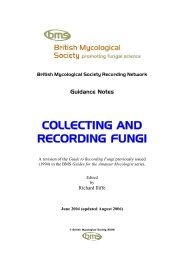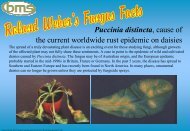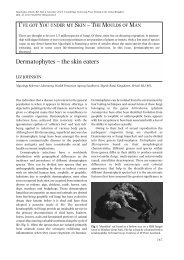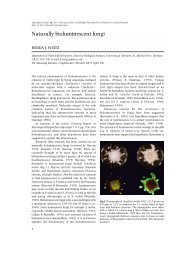Mycorrhizal fungi and their multifunctional roles - Cambridge Journals
Mycorrhizal fungi and their multifunctional roles - Cambridge Journals
Mycorrhizal fungi and their multifunctional roles - Cambridge Journals
You also want an ePaper? Increase the reach of your titles
YUMPU automatically turns print PDFs into web optimized ePapers that Google loves.
Mycologist, Volume 18, Part 2 May 2004. ©<strong>Cambridge</strong> University Press Printed in the United Kingdom.<br />
DOI: 10.1017/S0269915XO4002058<br />
<strong>Mycorrhizal</strong> <strong>fungi</strong> <strong>and</strong> <strong>their</strong> <strong>multifunctional</strong> <strong>roles</strong><br />
ROGER D. FINLAY<br />
Department of Forest Mycology & Pathology, SLU, Box 7026, SE-750 07 Uppsala, Sweden.<br />
Tel. +46 (0)18 671554, Fax. +46 (0)18 673599, e-mail: Roger.Finlay@mykopat.slu.se<br />
The effects of mycorrhizal <strong>fungi</strong> have traditionally been considered within the rather narrow perspective of <strong>their</strong><br />
effects on the mineral nutrition of individual plants. Most biologists are familiar with the idea that these<br />
symbiotic <strong>fungi</strong> may improve plant uptake of dissolved mineral nutrients. What other effects do these symbionts<br />
have? Research during the past 20 years has increasingly viewed symbiotic mycorrhizal associations between<br />
plants <strong>and</strong> <strong>fungi</strong> within a wider, <strong>multifunctional</strong> perspective. New molecular methods have been applied to<br />
investigate mycorrhizal fungal communities (Bruns & Bidartondo, 2002) <strong>and</strong> greater attention has been paid to<br />
<strong>their</strong> possible effects at the level of the plant community. As we have acquired greater knowledge about fungal<br />
species diversity, so we have become more aware of the potential functional diversity of mycorrhizal <strong>fungi</strong>. The new<br />
<strong>multifunctional</strong> perspective includes mobilisation of N <strong>and</strong> P from organic polymers, possible release of nutrients<br />
from mineral particles or rock surfaces via weathering, effects on carbon cycling, interactions with<br />
myco-heterotrophic plants, mediation of plant responses to stress factors such as drought, soil acidification, toxic<br />
metals <strong>and</strong> plant pathogens, as well as a range of possible interactions with groups of other soil microorganisms.<br />
Keywords: Microbial interactions, mycorrhizal <strong>fungi</strong>,<br />
nutrient cycling, plant communities, weathering, stress<br />
Introduction<br />
Symbiotic mycorrhizal <strong>fungi</strong> influence the terrestrial<br />
environment in different ways, either through direct<br />
interactions with the mineral or organic substrates that<br />
they colonise, or indirectly, via interactions with <strong>their</strong><br />
host plants or other organisms. Traditionally, research<br />
has been dominated by studies of the effects of<br />
mycorrhizal <strong>fungi</strong> on the growth <strong>and</strong> nutrient status of<br />
individual plants, mostly concentrating on the uptake<br />
of mineral nutrients. More recently there has been<br />
increased focus on the ways in which mycorrhizal <strong>fungi</strong><br />
affect the functioning of plant communities <strong>and</strong><br />
ecosystems, <strong>and</strong> greater attention has been paid to the<br />
role of the <strong>fungi</strong> in releasing plant growth limiting<br />
nutrients such as N <strong>and</strong> P from organic polymers. This<br />
research is leading to a better awareness of the ways in<br />
which different types of mycorrhizal <strong>fungi</strong> contribute to<br />
the development <strong>and</strong> dominance of distinctive plant<br />
communities at different spatial scales. The current<br />
‘<strong>multifunctional</strong>’ perspective of mycorrhizal symbiosis<br />
also takes account of the ways in which mycorrhizal<br />
<strong>fungi</strong> influence carbon partitioning <strong>and</strong> cycling within<br />
plant ecosystems, as well as the different ways in which<br />
the symbiosis may influence plant responses to stress<br />
factors such as drought, soil acidification, toxic metals<br />
<strong>and</strong> plant pathogens. There is also increasing<br />
recognition of the possible ways in which mycorrhizal<br />
<strong>fungi</strong> interact with other groups of microorganisms<br />
<strong>and</strong> so influence nutrient cycling. These different<br />
environmental effects are outlined in Fig 1 <strong>and</strong><br />
discussed in greater detail below.<br />
Mobilisation <strong>and</strong> uptake of mineral nutrients<br />
The effects of mycorrhizal mycelia on the uptake of<br />
dissolved mineral nutrients are well documented<br />
(Smith & Read, 1997). In ectomycorrhizal <strong>and</strong><br />
arbuscular-mycorrhizal associations at least, the<br />
mycorrhizal mycelium provides an increased surface<br />
area for nutrient uptake <strong>and</strong> improves the nutrient<br />
acquisition of the host plants. The hyphae are also able<br />
to penetrate small microsites that are inaccessible to the<br />
much coarser plant roots. Active uptake of poorly<br />
mobile nutrients such as phosphorus leads to the<br />
formation of nutrient-depleted volumes of soil around<br />
roots, which the mycorrhizal hyphae are able to bridge,<br />
supplying nutrients from more distant soil. In some<br />
ectomycorrhizal fungal species, differentiated<br />
structures such as fungal rhizomorphs facilitate<br />
translocation of nutrients over long distances.<br />
Although it is well accepted that mycorrhiza assist<br />
in acquisition of mineral nutrients already in the soil<br />
91
Mycologist, Volume 18, Part 2 May 2004<br />
Fig 1 Possible environmental effects of mycorrhizal <strong>fungi</strong> include effects on mineral nutrient uptake <strong>and</strong> availability,<br />
mediation of different types of plant stress, mobilisation of organic nutrients, interactions with other organisms, effects<br />
on carbon cycling <strong>and</strong> effects on plant communities. These are illustrated by examples, but each effect does not necessarily<br />
apply to all types of mycorrhizal <strong>fungi</strong> (Figures from Mycorrhiza <strong>and</strong> New Phytologist appear courtesy of Springer <strong>and</strong><br />
Blackwell respectively).<br />
92
Mycologist, Volume 18, Part 2 May 2004<br />
solution, there has recently been increasing interest in<br />
the idea that mycorrhizal mycelia, either by themselves,<br />
or in association with bacteria or other <strong>fungi</strong>, may<br />
actively release nutrients from mineral particles <strong>and</strong><br />
rock surfaces through weathering (L<strong>and</strong>eweert et al.,<br />
2001). Evidence for arbuscular mycorrhizal (AM) <strong>fungi</strong><br />
is conflicting <strong>and</strong> although there is some evidence of<br />
increased use of relatively insoluble forms of inorganic<br />
P such as rock phosphate, these effects could depend<br />
upon synergistic interactions with other P-solubilising<br />
microorganisms (see interactions with other organisms<br />
– below). Low molecular weight (LMW) organic acids<br />
have been proposed to play a role in weathering of<br />
minerals <strong>and</strong> there have been frequent reports of <strong>their</strong><br />
production by ectomycorrhizal <strong>fungi</strong> (Ahonen-<br />
Jonnarth et al., 2000).<br />
Jongmans et al. (1997) published evidence<br />
suggesting that weatherable minerals in podzol<br />
surface soils <strong>and</strong> shallow granitic rock under<br />
European coniferous forests were commonly<br />
criss-crossed by networks of tubular pores 3-10 µm<br />
in diameter. The aetiology of these has still not<br />
been established but the authors speculated that<br />
they might be caused by hyphae of ectomycorrhizal<br />
<strong>fungi</strong> exuding organic acids at <strong>their</strong> tips. According<br />
to the theory, the host trees would provide important<br />
sinks for the nutrients released through dissolution<br />
in the pores <strong>and</strong> mycorrhizal hyphae would provide<br />
direct conduits for translocation of nutrients to<br />
plants from microsites isolated from the bulk soil<br />
solution. Irrespective of whether these pores are<br />
actually formed by mycorrhizal hyphae or not, there<br />
is clearly a large potential for interaction between<br />
mycorrhizal hyphae <strong>and</strong> mineral surfaces <strong>and</strong> recent<br />
research by Rosling et al. (2003) revealed that<br />
at least 50% of the mycorrhizal fungal taxa found<br />
in a podzol soil in the north of Sweden were<br />
exclusively associated with the mineral soil horizons.<br />
Surprisingly, this is the first detailed study to consider<br />
ectomycorrhizal taxa throughout the soil profile since<br />
almost all studies are confined to the upper organic<br />
horizons. Further studies of different <strong>fungi</strong> <strong>and</strong> <strong>their</strong><br />
responses to different mineral substrates (Mahmood<br />
et al., 2001; Rosling et al., 2004) have revealed<br />
significant variation in the responses of different<br />
<strong>fungi</strong>. Studies by Wall<strong>and</strong>er et al. (2002) using<br />
particle-induced X-ray emission (PIXE) analysis of<br />
element contents of fungal rhizomorphs also<br />
suggested that an ectomycorrhizal Rhizopogon<br />
species had the ability to mobilise significant<br />
amounts of P <strong>and</strong> K from the minerals apatite <strong>and</strong><br />
biotite <strong>and</strong> probably plays a significant role in<br />
transporting these to trees.<br />
Nutrient mobilisation from organic substrates<br />
During recent years increasing emphasis has been<br />
placed upon the ability of mycorrhizal <strong>fungi</strong> to mobilise<br />
N <strong>and</strong> P from organic polymers (Read, 1991). The idea<br />
that the supply of N <strong>and</strong> P to plants is totally dependent<br />
on the nutrient mobilising activities of decomposers<br />
has been increasingly challenged by observations of the<br />
ability of mycorrhizal <strong>fungi</strong> to sequester N <strong>and</strong> P from a<br />
range of biologically relevant substrates such as pollen,<br />
dead nematodes <strong>and</strong> soil micro-arthropods as well as<br />
saprotrophic mycelia (Lindahl et al., 1999; Read &<br />
Perez-Moreno, 2003). Intervention by different groups<br />
of mycorrhizal <strong>fungi</strong> in microbial mobilisationimmobilisation<br />
cycles, resulting in mobilisation of N<br />
<strong>and</strong> P from microbial, micro-faunal, meso-faunal <strong>and</strong><br />
plant litter, has thus enabled the development of<br />
distinctive plant communities along altitudinal or<br />
latitudinal gradients. This is particularly evident in the<br />
ericoid mycorrhizal <strong>fungi</strong> colonising heathl<strong>and</strong><br />
ecosystems <strong>and</strong> in ectomycorrhizal <strong>fungi</strong> colonising<br />
boreal forest ecosystems. In these ecosystems, where N<br />
<strong>and</strong> P are sequestered in organic forms that are not<br />
readily available to autotrophs, the dominant plant<br />
species are highly dependent on mycorrhizal symbionts<br />
for <strong>their</strong> nutrient supply. More research is needed on<br />
arbuscular mycorrhizal <strong>fungi</strong> <strong>and</strong> it is possible that<br />
relevant species have not yet been investigated since<br />
there has been a general concentration on agricultural<br />
systems. AM <strong>fungi</strong> may be associated with decaying<br />
organic matter in some ecosystems, <strong>and</strong> Hodge et al.<br />
(2001) demonstrated enhanced decomposition <strong>and</strong> N<br />
capture from decaying grass leaves in the presence of<br />
AM <strong>fungi</strong>. However, further research is still needed to<br />
distinguish between the direct capacity of AM <strong>fungi</strong> to<br />
mobilise organic substrates <strong>and</strong> <strong>their</strong> possible, indirect<br />
effects on decomposition <strong>and</strong> plant nutrient uptake,<br />
caused by stimulation of decomposers <strong>and</strong> subsequent<br />
uptake of <strong>their</strong> decomposition products by mycorrhizal<br />
hyphae. This problem is further discussed below in<br />
relation to interactions with other microorganisms.<br />
Effects on carbon cycling<br />
Loss of energy-rich carbon compounds from plant roots<br />
to soil microbial populations constitutes a fundamental<br />
supply process to the soil ecosystem <strong>and</strong> the effects of<br />
mycorrhizal <strong>fungi</strong> on carbon flow to the soil have been<br />
reviewed by Finlay & Söderström (1992). Significant<br />
amounts of carbon flow through mycorrhizal mycelia<br />
to different components of the soil ecosystem <strong>and</strong> the<br />
cost of maintaining ectomycorrhizal associations has<br />
been estimated by different authors to be between 15%<br />
93
Mycologist, Volume 18, Part 2 May 2004<br />
<strong>and</strong> 28% of net carbon fixation. Recent experiments by<br />
Högberg et al. (2001) used girdling of forest trees to<br />
distinguish the relative contributions of roots <strong>and</strong><br />
ectomycorrhizal <strong>fungi</strong> <strong>and</strong> free-living microbial<br />
heterotrophs (decomposers) to soil respiration.<br />
Decreases of over 50% in soil respiration were found<br />
following girdling, suggesting that the flow of current<br />
assimilates is a major driver of soil respiration. Apart<br />
from direct respiratory loss, energy rich carbon<br />
compounds are required for most biological processes<br />
<strong>and</strong> further information is needed about the amounts<br />
<strong>and</strong> types of different compounds <strong>and</strong> the mechanisms<br />
regulating <strong>their</strong> translocation <strong>and</strong> ultimate<br />
partitioning. Potential effects include production of<br />
enzymes, organic acids <strong>and</strong> other compounds<br />
influencing the degradation of organic substrates or<br />
solubilisation of mineral substrates <strong>and</strong> production of<br />
antibiotic substances involved in chemical defence or<br />
antagonism. Production of glycoproteins such as<br />
glomalin that are involved in the formation <strong>and</strong><br />
stability of soil aggregates may also have an important<br />
influence on other microorganisms associated with the<br />
arbuscular mycorrhizal mycelium (Johansson et al.,<br />
2004) (see - Interactions with other organisms).<br />
Although allocation of carbon may be increased in<br />
ectomycorrhizal mycelia colonising patches of<br />
decomposing plant litter, Leake et al. (2001) showed<br />
that allocation of carbon to mycorrhizal mycelia<br />
interacting with the mycelium of the wood decomposer<br />
Phanerochaete velutina was reduced.<br />
There has been intensive discussion <strong>and</strong><br />
controversy about the ultimate fate of carbon reaching<br />
the mycorrhizal mycelium <strong>and</strong> the possible significance<br />
of any transfer between plants connected by shared<br />
hyphal networks. Some authors (Simard et al., 1997)<br />
contend that the amounts of C transferred can be<br />
ecologically significant, while other authors (Robinson<br />
& Fitter, 1999) question the significance of the process,<br />
or advocate a more mycocentric viewpoint (Fitter et al.,<br />
2000). Finlay & Söderström (1992) pointed out that<br />
connection of plants to a common mycelial network<br />
could be of significance without needing to invoke any<br />
arguments concerning net interplant transfer of<br />
carbon, since seedlings could gain access to a large<br />
absorptive network of hyphae with minimal investment<br />
of carbon. The results of Högberg et al. (1999) are<br />
consistent with the above argument since the authors<br />
found that promiscuous ectomycorrhizal <strong>fungi</strong> forming<br />
associations with several tree species had natural<br />
13<br />
signatures of C closer to those of overstorey trees,<br />
suggesting that the overstorey trees partly or wholly<br />
support the carbon dem<strong>and</strong>s of the nutrient absorbing<br />
mycelia of <strong>their</strong> alleged competitors, the understorey<br />
trees. Transfer of carbon may also occur between green<br />
plants <strong>and</strong> non-photosynthetic, myco-heterotrophic<br />
plants sharing the mycelium (see - Effects on plant<br />
communities <strong>and</strong> ecosystems).<br />
Effects on plant communities <strong>and</strong> ecosystems<br />
The floristic diversity <strong>and</strong> productivity of reconstructed<br />
grassl<strong>and</strong> communities have been shown<br />
to depend upon the presence of a species-rich<br />
assemblage of arbuscular mycorrhizal species (van der<br />
Heijden et al., 1998). In these experiments increasing<br />
fungal diversity resulted in greater species diversity <strong>and</strong><br />
higher productivity, suggesting that changes in<br />
belowground diversity of mycorrhizal symbionts can<br />
drive changes in above ground diversity <strong>and</strong><br />
productivity. The mechanism behind these effects is<br />
likely to be differential effects of specific plant–fungus<br />
combinations on the growth of different plant species.<br />
This is consistent with the idea emerging from many<br />
molecular studies, that the degree of mycorrhizal<br />
specificity may be higher than hitherto supposed. If<br />
addition of new fungal species leads to increases in the<br />
survival <strong>and</strong> vigour of more plant species that are<br />
responsive to mycorrhizal colonisation then there may<br />
be a positive feedback on the mycorrhizal <strong>fungi</strong>, leading<br />
to more efficient resource utilisation <strong>and</strong> increases in<br />
overall productivity. The ecological significance of the<br />
possible transfer of photosynthetically derived carbon<br />
between different plant species is still questioned by<br />
some scientists (Robinson & Fitter, 1999) but there is<br />
substantial evidence to suggest that it may be of great<br />
significance to myco-heterotrophic plant species.<br />
Although the fungal associates <strong>and</strong> carbon sources of<br />
most myco-heterotrophic plants have so far not been<br />
identified, several more closely examined nonphotosynthetic<br />
plant species have been revealed to be<br />
effectively epiparasitic on green plants, obtaining <strong>their</strong><br />
carbon via hyphal connections with shared arbuscular<br />
(Bidartondo et al., 2002) or ectomycorrhizal fungal<br />
associates (Taylor & Bruns, 1997; McKendrick et al.,<br />
2000).<br />
Mediation of plant responses to stress<br />
Although mycorrhizal <strong>fungi</strong> are themselves affected by<br />
environmental perturbations, they also have the ability<br />
to mediate the responses of plants to different types of<br />
environmental stress. The ability of ectomycorrhizal<br />
<strong>fungi</strong> to capture base cations <strong>and</strong> restrict <strong>their</strong> loss<br />
through leaching, <strong>and</strong> to release nutrients through<br />
weathering of mineral surfaces, may be important in<br />
environments influenced by soil acidification (Ahonen-<br />
94
Mycologist, Volume 18, Part 2 May 2004<br />
Jonnarth et al., 2003). In such soils the toxicity of the<br />
resulting elevated concentrations of Al <strong>and</strong> other toxic<br />
metals may be reduced by increased production of<br />
chelating agents such as oxalic acid (Ahonen-Jonnarth<br />
et al., 2000). The effects of mycorrhizal <strong>fungi</strong> on plant<br />
responses to drought stress have been discussed by a<br />
number of authors (Smith & Read, 1997) but it is<br />
difficult to separate nutritional effects from direct<br />
effects on water transport since the hyphal contribution<br />
to nutrient uptake becomes more important as soil<br />
dries. Recent experiments by Quiereta et al. (2003),<br />
however, have shown nocturnal water translocation<br />
from plant roots to mycorrhizal <strong>fungi</strong> in association<br />
with hydraulic lift. Supply of water in this way would be<br />
an important way of maintaining mycorrhizal activity<br />
<strong>and</strong> improving nutrient uptake by deep rooted plants,<br />
even when fertile upper soil horizons are dry. The<br />
exudation of liquid droplets at ectomycorrhizal hyphal<br />
tips has also been discussed by Sun et al. (1999) who<br />
suggested that this would help to maintain better<br />
continuity between hyphal tips <strong>and</strong> the adjacent<br />
substrate, as well as more stable conditions for<br />
microbial interactions at this interface.<br />
Interactions with other microorganisms<br />
In addition to increasing the absorptive surface area of<br />
<strong>their</strong> host plant root systems, the hyphae of symbiotic<br />
<strong>fungi</strong> provide an increased surface area for interactions<br />
with other microorganisms, <strong>and</strong> provide an important<br />
pathway for the translocation of energy-rich plant<br />
assimilates (products of photosynthesis) to the soil. The<br />
interactions may be synergistic, competitive or<br />
antagonistic <strong>and</strong> may have applied significance in areas<br />
such as sustainable agriculture (Johansson et al.,<br />
2004), biological control or bioremediation. Bacteria<br />
with potential to fix nitrogen have been discovered<br />
growing endosymbiotically within arbuscular<br />
mycorrhizal hyphae, as well as in association with<br />
tuberculate roots of ectomycorrhizal plants. Obviously<br />
such tripartite symbioses would be of significance in<br />
nitrogen-limited environments. Exudation <strong>and</strong> reabsorption<br />
of fluid droplets at ectomycorrhizal hyphal<br />
tips was demonstrated by Sun et al. (1999) who<br />
concluded that it might represent an important<br />
mechanism for conditioning the hyphal environment<br />
in the vicinity of tips, creating an interface for<br />
exchange of nutrients <strong>and</strong> carbon compounds with the<br />
adjacent soil environment <strong>and</strong> its other<br />
microorganisms. The extent to which interactions<br />
between mycorrhizal mycelia <strong>and</strong> other<br />
microorganisms influence different organic or mineral<br />
substrates is still unclear <strong>and</strong> further experiments are<br />
needed to distinguish between the activity of<br />
mycorrhizal hyphae themselves <strong>and</strong> facilitated<br />
mycorrhizal uptake of compounds mobilised by the<br />
activities of other organisms.<br />
Conclusions<br />
The role of symbiotic mycorrhizal <strong>fungi</strong> in shaping<br />
terrestrial ecosystems is fundamental. Many of the<br />
characteristic plant communities that dominate the<br />
major terrestrial biomes of the world do so today<br />
because selection has favoured different types of<br />
symbiotic associations that are adapted to the<br />
prevailing suites of soil, vegetation <strong>and</strong> climatic<br />
conditions characterising these different environments.<br />
As we learn more about the diversity of the <strong>fungi</strong><br />
involved <strong>and</strong> the specificity of <strong>their</strong> relationships with<br />
different plants, so we improve our underst<strong>and</strong>ing of<br />
the functional diversity of mycorrhizal symbioses. Old<br />
models, based solely on the mineral nutrition of<br />
individual plants, are giving way to new models with a<br />
broader functional basis, using more ecologically<br />
relevant species <strong>and</strong> substrates. Comparative analysis of<br />
different systems will improve our underst<strong>and</strong>ing of<br />
responses to environmental <strong>and</strong> climatic perturbations.<br />
This new knowledge is an important pre-requisite for<br />
future, sustainable management of terrestrial<br />
ecosystems.<br />
Acknowledgements<br />
Financial support from the European Commission<br />
(grant CT96-1377), the Swedish Research Council<br />
(VR), the Swedish Research Council for Environment,<br />
Agricultural Sciences <strong>and</strong> Spatial Planning (FORMAS),<br />
the Swedish Environmental Protection Agency (SNV)<br />
<strong>and</strong> the Swedish Energy Administration (STEM) is<br />
gratefully acknowledged. I would also like to thank<br />
Torgny Unestam, Andy Taylor, Björn Lindahl, Ulla<br />
Ahonen-Jonnarth <strong>and</strong> Anna Rosling for helpful<br />
discussions.<br />
References<br />
Ahonen-Jonnarth, U., Göransson, A. & Finlay, R. D. (2003).<br />
Growth <strong>and</strong> nutrient uptake of ectomycorrhizal Pinus<br />
sylvestris seedlings treated with elevated Al concentrations.<br />
Tree Physiology 23: 157–167.<br />
Ahonen-Jonnarth, U., Van Hees P. A. W., Lundström, U. S. &<br />
Finlay, R. D. (2000). Production of organic acids by<br />
mycorrhizal <strong>and</strong> non-mycorrhizal Pinus sylvestris L.<br />
seedlings exposed to elevated concentrations of aluminium<br />
<strong>and</strong> heavy metals. New Phytologist 146: 557-567.<br />
Bidartondo, M. I., Redecker, D., Hijri, I., Wiemken, A., Bruns,<br />
T. D., Domínguez, L., Sérsic, A., Leake, J. R. & Read, D. J.<br />
(2002). Epiparasitic plants specialized on arbuscular<br />
mycorrhizal <strong>fungi</strong>. Nature 419: 389-392.<br />
95
Mycologist, Volume 18, Part 2 May 2004<br />
Bruns, T. D. & Bidartondo, M. I. (2002). Molecular windows<br />
into the below-ground interactions of ectomycorrhizal<br />
<strong>fungi</strong>. Mycologist 16: 47-50.<br />
Finlay, R. D. & Söderström, B. (1992). Mycorrhiza <strong>and</strong> Carbon<br />
Flow to Soil. In: M. F. Allen, ed. <strong>Mycorrhizal</strong> Functioning, pp.<br />
134-160.Chapman & Hall, London.<br />
Fitter, A. H., Heinemeyer, A. & Staddon, P. L. (2000). The<br />
impact of elevated CO 2 <strong>and</strong> global climate change on<br />
arbuscular mycorrhizas: a mycocentric approach. New<br />
Phytologist 147:179-187.<br />
Hodge, A., Campbell, C. D. & Fitter, A. H. (2001). An<br />
arbuscular mycorrhizal fungus accelerates decomposition<br />
<strong>and</strong> acquires nitrogen directly from organic material.<br />
Nature 413: 297-299.<br />
Högberg, P., Nordgren, A., Buchmann, N., Taylor, A.F.S.,<br />
Ekblad, A., Högberg, M.N., Nyberg, G., Ottosson-Löfvenius,<br />
M., Read, D. J. (2001). Large-scale forest girdling shows that<br />
current photosynthesis drives soil respiration. Nature 411:<br />
789-792.<br />
Högberg, P., Plamboeck, A. H., Taylor, A.F.S. & Fransson,<br />
P.M.A. (1999). Natural 13 C abundance reveals trophic<br />
status of <strong>fungi</strong> <strong>and</strong> host-origin of carbon in mycorrhizal<br />
<strong>fungi</strong> in mixed forests. Proceedings of the National Academy of<br />
Science USA 96: 8534–8539.<br />
Johansson, J., Paul, L. & Finlay, R. D. (2004). Microbial<br />
interactions in the mycorrhizosphere <strong>and</strong> <strong>their</strong> significance<br />
for sustainable agriculture. FEMS Microbiology Ecology<br />
18: 1–13.<br />
Jongmans, A.G., van Breemen, N., Lundström, U., Finlay,<br />
R. D., van Hees, P. A. W, Giesler, R., Melkerud, P-A., Olsson,<br />
M., Srinivasan, M. & Unestam, T. (1997). Rock-eating<br />
<strong>fungi</strong>: a true case of mineral plant nutrition? Nature 389:<br />
682-683.<br />
L<strong>and</strong>eweert, R., Hofflund, E., Finlay, R. D. & van Breemen, N.<br />
(2001). Linking plants to rocks: Ectomycorrhizal <strong>fungi</strong><br />
mobilize nutrients from minerals. Trends in Ecology &<br />
Evolution 16: 248-254.<br />
Leake, J. R., Donnelly, D. P., Saunders, E. M., Boddy, L. & Read,<br />
D. J. (2001). Rates <strong>and</strong> quantities of carbon flux to<br />
ectomycorrhizal mycelium following 14 C pulse labeling of<br />
Pinus sylvestris seedlings: effects of litter patches <strong>and</strong><br />
interaction with a wood-decomposer fungus. Tree<br />
Physiology 21: 71-82.<br />
Lindahl, B., Stenlid, J., Olsson, S. & Finlay, R. (1999).<br />
Translocation of 32 P between interacting mycelia of a wood<br />
decomposing fungus <strong>and</strong> ectomycorrhizal <strong>fungi</strong> in<br />
microcosm systems. New Phytologist 144:183-193.<br />
Mahmood, S., Finlay, R. D., Erl<strong>and</strong>, S. & Wall<strong>and</strong>er, H.<br />
(2001). Solubilisation <strong>and</strong> colonisation of wood ash by<br />
ecto-mycorrhizal <strong>fungi</strong> isolated from a wood ash<br />
fertilised spruce forest. FEMS Microbiology Ecology 35:<br />
151-161.<br />
McKendrick, S.L., Leake, J.R. & Read, D.J. (2000). Symbiotic<br />
germination <strong>and</strong> development of mycoheterotrophic<br />
plants in nature: transfer of carbon from ectomycorrhizal<br />
Salix repens <strong>and</strong> Betula pendula to the orchid Corallorhiza<br />
trifida through shared hyphal connections. New Phytologist<br />
145: 539–548.<br />
Read, D. J. (1991). Mycorrhizas in ecosystems. Experientia 47:<br />
376-391.<br />
Read, D. J. & Perez-Moreno, J. (2003). Mycorrhizas <strong>and</strong><br />
nutrient cycling in ecosystems – a journey towards<br />
relevance? New Phytologist 157: 475-492.<br />
Querejeta, J. I., Egerton-Warburton, L. M. & Allen, M. F.<br />
(2003). Direct nocturnal water transfer from oaks to <strong>their</strong><br />
mycorrhizal symbionts during severe soil drying. Oecologia<br />
134: 55-64.<br />
Robinson, D. & Fitter, A.H. (1999). The magnitude <strong>and</strong><br />
control of carbon transfer between plants linked by a<br />
common mycorrhizal network. Journal of Experimental<br />
Botany 50: 9–13.<br />
Rosling, A., L<strong>and</strong>eweert, R., Lindahl, B. D., Larsson, K-H.,<br />
Kuyper, T.W., Taylor, A. F. S. & Finlay, R. D. (2003). Vertical<br />
distribution of ectomycorrhizal fungal taxa in a podzol<br />
profile determined by morphotyping <strong>and</strong> genetic<br />
verification. New Phytologist 159: 775-783.<br />
Rosling, A., Lindahl, B. D., Taylor, A. & Finlay, R. D. (2004).<br />
Mycelial growth <strong>and</strong> substrate acidification of<br />
ectomycorrhizal <strong>fungi</strong> in response to different minerals.<br />
FEMS Microbiology Ecology 47: 31-37.<br />
Simard, S.W., Perry, D.A., Jones, M.D., Myrold, D. D., Durall,<br />
D.M.. & Molina, R. (1997). Net transfer of carbon between<br />
ectomycorrhizal tree species in the field. Nature 388:<br />
579-582.<br />
Smith, S. E. & Read, D. J. (1997). <strong>Mycorrhizal</strong> Symbiosis.<br />
Academic Press, London.<br />
Sun, Y. P., Unestam, T., Lucas, S.D., Johanson, K. J., Kenne, L.<br />
& Finlay, R. (1999). Exudation-reabsorption in a<br />
mycorrhizal fungus, the dynamic interface for interaction<br />
with soil <strong>and</strong> soil microorganisms. Mycorrhiza 9: 137-144.<br />
Taylor, D. L. & Bruns, T. D. (1997). Independent, specialized<br />
invasions of ectomycorrhizal mutualism by two<br />
nonphotosynthetic orchids. Proceedings of the National<br />
Academy of Science USA 94: 4510–4515.<br />
van der Heijden, M. G. A., Klironomos, J. N., Ursic, M.,<br />
Moutoglis, P., Streitwolf-Engel, R., Boller, T., Wiemken, A. &<br />
S<strong>and</strong>ers, I. R. (1998). <strong>Mycorrhizal</strong> fungal diversity<br />
determines plant biodiversity, ecosystem variability <strong>and</strong><br />
productivity. Nature 396: 69-72.<br />
Wall<strong>and</strong>er, H., Johansson, L. & Pallon, J. (2002). PIXE<br />
analysis to estimate the elemental composition of<br />
ectomycorrhizal rhizomorphs grown in contact with<br />
different minerals in forest soil. FEMS Microbiology Ecology<br />
39: 147-156.<br />
96



